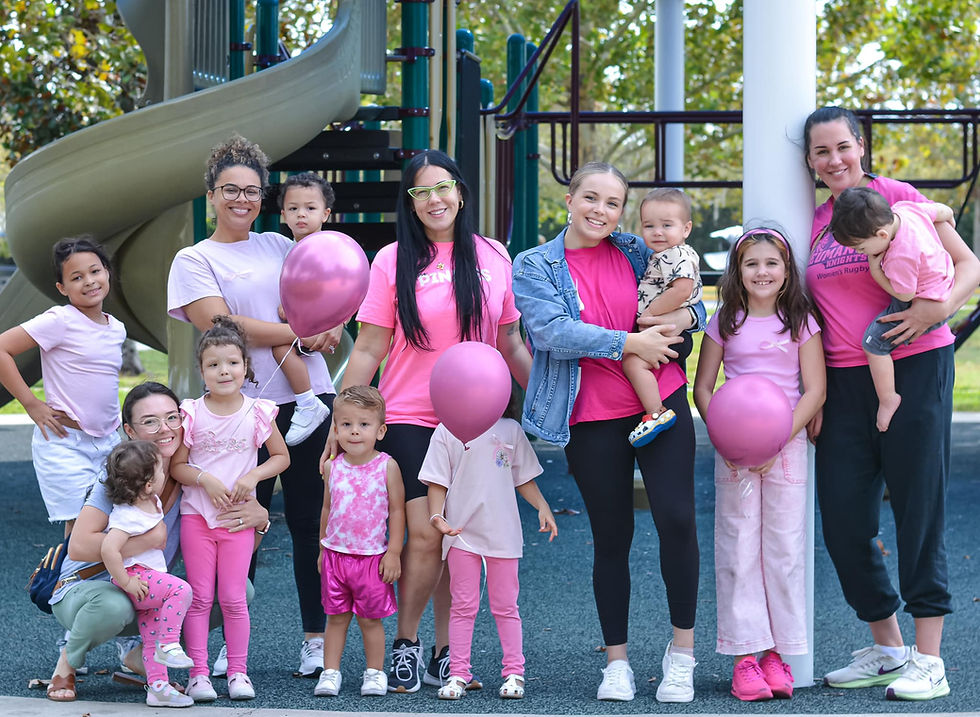The Real Reason We Showed Up Today: Breast Cancer Awareness and Why It Matters for Moms
- Nan

- Oct 28, 2024
- 4 min read

Today’s PDOO Walk for Cancer was more than just playground fun, balloons, and cute pink outfits. Don’t get me wrong—our littles looked adorable! But beyond the photos and the snacks, we gathered for something much deeper and important: bringing awareness to breast cancer and the power of checking ourselves regularly. It’s something we, as moms, owe to ourselves, our families, and especially our kids. So, let’s talk about why we need to make these checkups a top priority.
Why Getting Checked Matters
Breast cancer affects 1 in 8 women in the United States. That’s a major statistic, moms! And what’s really important is how early detection can be life-saving. According to the American Cancer Society, women who catch breast cancer early, while it’s still localized, have a survival rate of 99%. Those are some serious odds in our favor if we’re proactive. So, when we encourage you to feel for any lumps or changes, it’s not just talk. It’s a real step in the fight against this disease, and it’s a step we’re all capable of taking.
Why Moms Need to Step Up
We know that as moms, we juggle so much. Our kiddos come first, but here’s the thing: if we’re not healthy, who’s going to be there to keep showing up for them? And if that’s not reason enough, think of it like this—by making regular self-checks and doctor visits part of our lives, we’re setting an example. We’re teaching our kids about self-care, about health, and about taking charge of their own well-being.
Health organizations, like the CDC, remind us that regular checkups, mammograms (for those over 40), and being in tune with our own bodies can make all the difference. And the good news? Many places, even clinics and hospitals, offer free or low-cost screenings in October, especially during Breast Cancer Awareness Month.
But How Do You Actually Check?
You don’t need fancy equipment, mama. Start by getting to know how your own breasts feel normally. Use your fingers in a circular motion, checking all around the breast, underarms, and collarbone. If something feels different or new—a lump, thickening, or pain—make a call to your doctor. According to Mayo Clinic, most breast changes are not cancer, but it’s always better to know for sure.

Let’s Keep the Conversation Going
Today was all about awareness, about coming together, and yes, about looking cute in pink! But let’s remember why we do this. For our health, our peace of mind, and our beautiful kids who need us around, strong and healthy. Taking five minutes to check ourselves or book that appointment isn’t just self-care—it’s love and responsibility.
So, here’s to staying aware, staying healthy, and supporting each other every step of the way. Today was powerful, and it’s all because of our PDOO community coming together. Thank you for showing up and let’s keep showing up, for ourselves and for each other.
Resources for Breast Cancer Awareness and Support
1. American Cancer Society
- [American Cancer Society - Breast Cancer Resources](https://www.cancer.org/cancer/breast-cancer.html)
- They offer extensive resources on breast cancer symptoms, treatment, and prevention. They also have guides on how to perform a self-exam.
2. National Breast Cancer Foundation
- [National Breast Cancer Foundation - Self-Exam Guide](https://www.nationalbreastcancer.org/)
- This guide includes visual and written instructions on how to perform a self-exam, along with links to local resources.
3. Centers for Disease Control and Prevention (CDC)
- CDC Breast Cancer Page https://www.cdc.gov/cancer/breast/
- Provides statistical information, resources for support, and links to free or low-cost mammogram providers across the U.S.
4. Mayo Clinic - Breast Cancer Health
- Mayo Clinic - How to Do a Breast Self-Exam https://www.mayoclinic.org/
- Detailed explanations on how to self-examine, along with information on mammograms and other screenings.
5. Susan G. Komen Foundation
- Susan G. Komen - Understanding Breast Cancer https://www.komen.org/
- One of the leading organizations in breast cancer research, offering support services, education, and free resources for individuals affected by breast cancer.
How to Perform a Breast Self-Exam: Step-by-Step Guide
1. Start in the Shower
Use your fingers to move around your entire breast in a circular pattern, from the outside to the center. Check both breasts, and feel around the armpit area as well. Use light, medium, and firm pressure to feel all the different layers of breast tissue.
2. In Front of the Mirror
Stand with your arms at your sides and look for any changes in the shape, size, or skin texture of your breasts (dimpling, swelling, redness, etc.). Then, raise your arms high overhead and look for the same changes. Finally, rest your hands on your hips and press firmly to flex your chest muscles—this helps reveal any irregularities beneath the surface.
3. Lying Down
Lie down and place a pillow under your right shoulder. With your right arm behind your head, use your left hand to check your right breast and armpit area in a circular motion, using light to firm pressure. Repeat on the other side.
Visuals for Self-Exam Steps
To accompany this guide, I recommend using these image resources:
- American Cancer Society has step-by-step visuals on how to perform a breast self-exam https://www.cancer.org/cancer/breast-cancer.html
- National Breast Cancer Foundation provides a free downloadable guide with self-check illustrations on their Self-Exam Page https://www.nationalbreastcancer.org/
If you need high-quality images, you can also check free medical illustration sites like Medical News Today or CDC Image Library for educational purposes.



















Comments